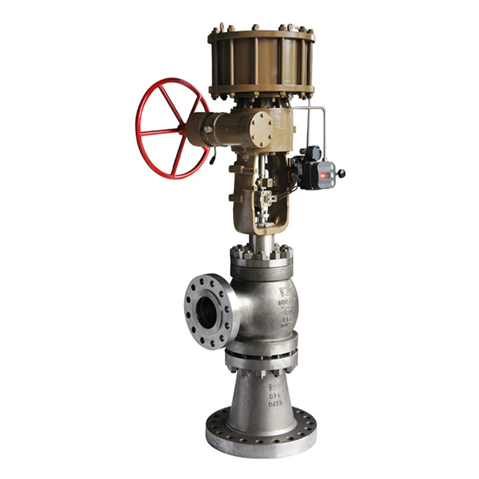Magpie Valve Selection: Accurate Matching Ensures Reliable Control
Valve Technology Sharing
Maintenance and Troubleshooting Guide for Angle Valve Internals in Coal Chemical Black Water Systems
Complete Repair Plan for 10-inch 900 LB Black Water Angle Valves: Focused on Erosion and Cavitation Restoration and Protection
In the coal chemical industry, the black water system, a solid-liquid mixture containing coal slag, ash water, and acidic media, poses a severe challenge to valve components through erosion, cavitation, and wear. This document presents a comprehensive internal repair solution for 10-inch (DN250) Class 900 high-pressure black water angle valves, focusing on critical components such as the annular seat, stem, and packing. Tailored to on-site conditions, the plan integrates damage mechanism analysis, restoration process design, and material upgrades to help coal chemical enterprises reduce costs, enhance efficiency, and extend valve service life.

Damage Characteristics: Honeycomb-like pitting on the sealing surface (0.5–2 mm deep); grooved wear caused by coal slag particles (50–200μm) along the edge. Under high differential pressure (4–8 MPa for Class 900), fluid velocity exceeds 20 m/s, causing cavitation perforation, especially at abrupt flow transitions.
Root Cause: High solids content (5%–15%), acidic pH (4–6), and the 90° angle valve geometry create a turbulent flow with frequent bubble collapse—ideal for compound erosion and cavitation.
Damage Characteristics: Linear scratches (0.1–0.3 mm deep) at the packing gland due to friction and particle embedding. Intergranular corrosion on the threaded section, leading to rough texture and a drop in hardness from HB200 to below HB150.
Damage Characteristics: Traditional graphite packing cracks under high temperatures (150–200°C), causing layer separation and valve stem leakage (>10 drops/min). Inner wall erosion of the stuffing box creates a rough concave surface, accelerating packing wear (reducing life from 3 months to 1 month).
Steps:
Disassemble the seat, grind flat using hard alloy paste (W10) until surface roughness Ra ≤ 0.8μm.
Perform dye penetrant testing (PT) to detect micro-cracks.
Apply HVOF tungsten carbide (WC-Co) coating (0.3 mm thick) with hardness up to HV1200, improving erosion resistance by 4×.
Severe Damage (Pitting ≥1 mm or cavitation perforation)
Replace with Hastelloy C-276 seat, offering 3× better acid resistance and high-temperature strength than 316L.
Overlay Stellite 6 (2–3 mm thick); post weld heat treatment yields HRC48–52 hardness.
CNC grind the sealing surface to <0.02 mm flatness deviation for optimal fit.
Add a 15° inlet chamfer to reduce turbulence.
Integrate a multi-hole throttling sleeve (Ø3 mm holes) to stage the pressure drop (ΔP ≤ 2 MPa per stage), reducing cavitation by 70%.
Lathe-finish to remove damaged layer (0.5 mm), precision IT7.
Hard chrome plating (0.05 mm) to form a dense, wear-resistant HV800 coating.
Apply MoS₂ solid lubricant on threads to reduce torque by 30% and lower packing friction.
Upgrade from 316L to 2507 super duplex stainless steel (PREN 43), 5× pitting resistance, ≥1000 MPa tensile strength.
Add an Inconel 718 locking ring at the stem-disc joint to prevent loosening under frequent cycling (looseness rate drops from 20% to <5%).
Replace traditional graphite with flexible graphite + carbon fiber reinforcement, impregnated with nickel-based corrosion inhibitors:
Handles up to 550°C and 10 MPa.
Reinforced for 50% better extrusion resistance.
Nickel inhibitor limits electrochemical corrosion, extending life from 1 month to over 6 months.
Measure internal diameter; if wear >0.3 mm, apply laser cladding with stainless steel powder (0.5 mm), then bore to nominal size (H8).
Machine a 0.5 mm deep spiral groove (5 mm pitch) to distribute media evenly and reduce localized erosion (packing flow velocity cut by 40%).
Valve Seat / Stem: Spectrometry (composition confirmation) + Hardness Testing (seat HRC48–52; stem HV800±50).
Packing: Compression rebound test (≥70% at 200°C/10 MPa) + acid immersion (pH 4, 48 hr, <1% mass loss).
Hydrostatic: 1.5× rated pressure (15.0 MPa), hold 30 min—no visible leaks.
Helium leak test: 1.1× rated pressure (11.0 MPa), <1×10⁻⁶ Pa·m³/s—far exceeding API 598.
Simulate black water with 10% quartz sand (100μm, pH 5), 20 m/s flow at 8 MPa ΔP, 1000 open-close cycles:
Seat wear <0.1 mm
Stem leakage <5 drops/min
For superficial damage, opt for overlay or coating repair (60% cost savings). For overlays >3 mm, apply post-weld stress relief (650°C, 2 hr) to avoid cracking.
Use application-specific materials:
Component Conventional Material Upgraded Material Core Benefit
Valve Seat 316L Hastelloy C-276 + Stellite Overlay Acid/cavitation resistance; 3× life
Valve Stem 304 2507 Super Duplex Erosion + intergranular corrosion resistance
Packing Standard Graphite Flexible Graphite + Carbon Fiber High-temp seal for frequent cycling
Maintain ≥5D straight pipe length before valve inlet to reduce turbulence.
Recommend installing hydrocyclones (≥50μm separation) to lower solids—extending repair cycles from 3 months to 1 year (based on olefin project data).
Repairing black water angle valves in coal chemical plants is essentially an ongoing battle against extreme service conditions. From overlay repairs on annular seats to material upgrades on valve stems and enhanced packing structures, every detail must address erosion, cavitation, and leakage resistance. Choosing targeted repair and material enhancement over simple replacement can reduce maintenance costs by over 50%, while extending service intervals from quarterly to over one year of stable operation.
Facing valve wear or leakage issues? Contact us for a custom repair solution. We specialize in coal chemical valve restoration with over 10 years of experience, offering end-to-end services from field inspection to testing. Let our expertise ensure your valves stand strong against black water's harshest challenges.
